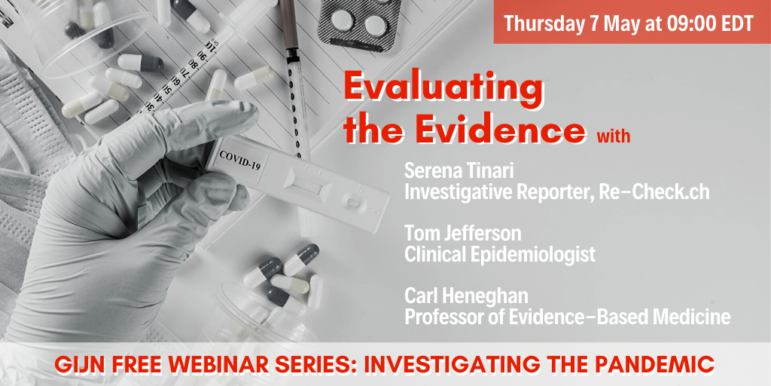
Editor’s note: This webinar has now taken place. You can see the recording on GIJN’s YouTube channel.
The COVID-19 pandemic narrative is dominated by numbers — mountains of data and seemingly endless statistical models. These are widely used by public officials and journalists, and dominate public briefings and news coverage. Yet most of the figures are uncertain at best, often highly flawed and simply untrue at worst. How to deal with the many claims on the truth that are made every day? What should journalists do if the evidence is poor? This webinar, Evaluating the Evidence, will look at some of the numbers and explain what they mean — and don’t mean — and provide critical tips on which figures do matter and where to find them.
With the help of three experts, all with a background in investigation, this webinar will also focus on the critical importance of evidenced-based methodology to investigate medicine and health, and the COVID-19 crisis in particular. You’ll have a chance to ask questions about the COVID-19 numbers, statistics, and models being used and quoted in your country.
- Serena Tinari is an investigative journalist who specialises in health and medicine, and for two years from 2009 reported extensively on the H1N1 pandemic and Tamiflu. She will share her strategies, tips and tools to dig deeper into Covid-19, bringing together the standards and ethics of evidence-based medicine with investigative reporting.
- Tom Jefferson is a clinical epidemiologist and researcher based in Rome. He will focus on how to deal with the many gaps in our knowledge and what to watch for as new data emerges. A contributor to the Oxford University Covid-19 Evidence Service, Jefferson is focusing on the lessons from two of Italy’s Covid-19 epicentres, the evidence so far on masks, and what we can learn from the great plague of 1630 in Lombardy.
- Carl Heneghan, a professor of evidence-based medicine at Oxford University and also a contributor to the Oxford COVID-19 Evidence Service, will explain when journalists can make use of models – and when they shouldn’t, and how to understand an epidemic wave. He will also outline some key questions he thinks investigative journalists should be asking.
This one-hour webinar is free and designed for journalists interested in investigating the pandemic. We recommend that, prior to the webinar, you read the material in the links provided. This is the seventh in a GIJN series, Investigating the Pandemic. Watch our Twitter feed @gijn and newsletter for future events.
